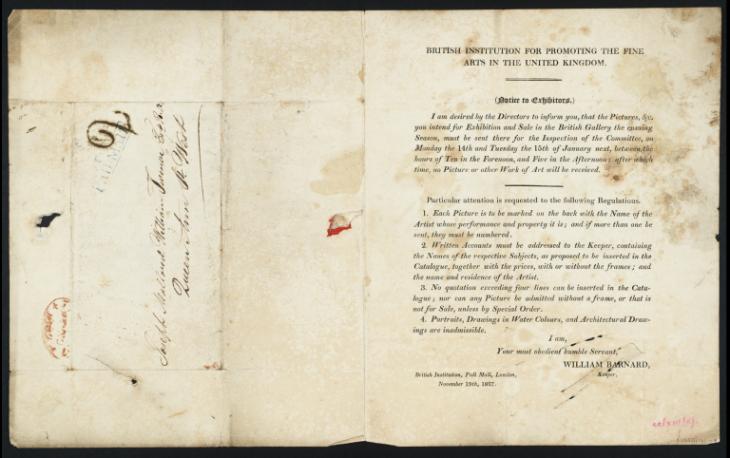Turner used the other side of this document (Tate
D25523; Turner Bequest CCLXIII a 8) for compositional studies, apparently for the major painting
Dido Directing the Equipment of the Fleet, or The Morning of the Carthaginian Empire, exhibited at the Royal Academy in 1828 (Tate
N00506)
1 and evidently in the planning stage in late 1827 or soon afterwards.
Addressed by hand to ‘Joseph Mallord William Turner Esq., R.A. | Queen Ann St. West’, the text of the printed notice in the right-hand half of this side is as follows:
BRITISH INSTITUTION FOR PROMOTING THE FINE ARTS IN THE UNITED KINGDOM.
I am desired by the Directors to inform you, that the Pictures, &c. that you intend for Exhibition and Sale in the British Gallery the ensuing Season, must be sent there for the Inspection of the Committee, on Monday the 14th and Tuesday the 15th of January next, between the hours of Ten in the Forenoon, and Five in the Afternoon; after which time, no Picture or other Work of Art will be received.
Particular attention is requested to the following Regulations.
1. Each Picture is to be marked on the back with the Name of the Artist whose performance and property it is; and if more than one be sent, they must be numbered.
2. Written Accounts must be addressed to the Keeper, containing the Names of the respective Subjects, as proposed to be inserted in the Catalogue, together with the prices, with or without the frames; and the name and residence of the Artist.
3. No quotation exceeding for lines can be inserted in the Catalogue; nor can any Picture be admitted without a frame, or that is not for Sale, unless by Special Order.
4. Portraits, Drawings in Water Colours, and Architectural Drawings are inadmissible.
I am,
Your most obedient humble Servant,
WILLIAM BARNARD,
Keeper.
British Institution, Pall Mall, London,
November 19th, 1827.
Turner had first exhibited at the British Institution, the main London rival to his beloved Royal Academy, in the organisation’s first exhibition, held in 1806 after its foundation the previous year. He continued to show there intermittently, with a gap between 1817 and 1835;
2 as this standard invitation for submissions is addressed to him personally, the Directors evidently continued to solicit his involvement in the intervening years. His lack of interest at this stage is demonstrated by his casual use of the other side for such slight drawings.

